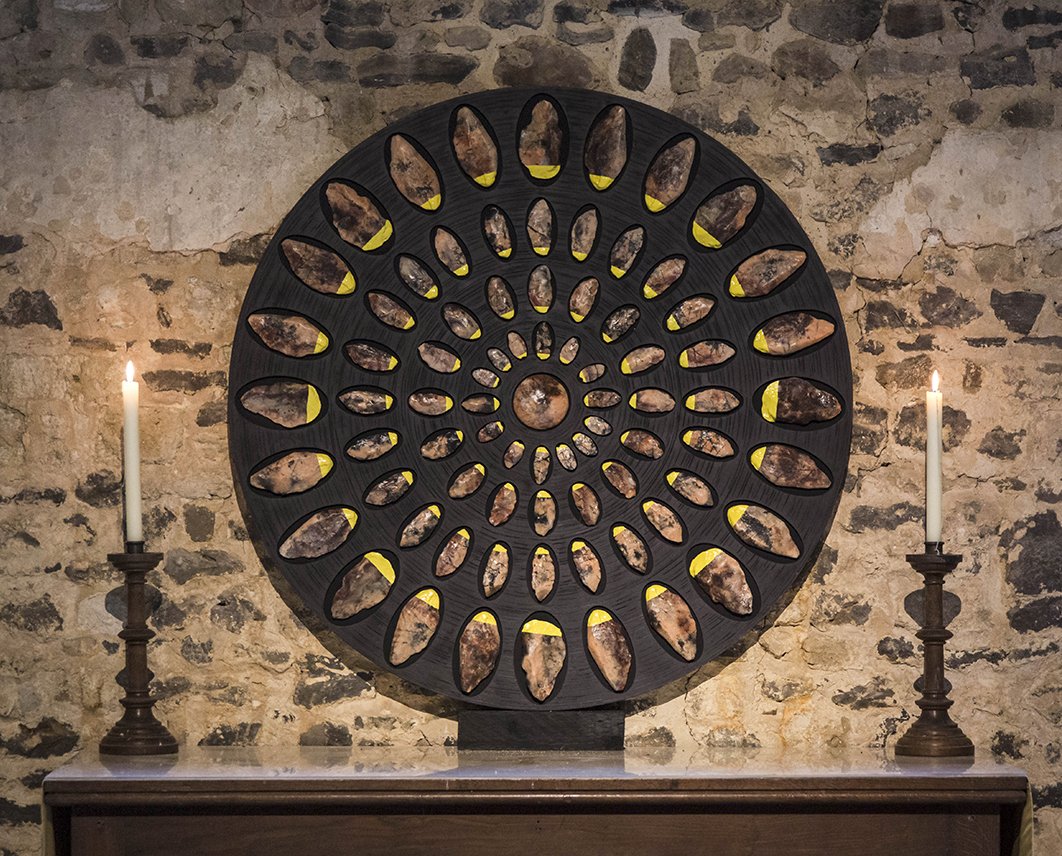Solastalgia Exhibition
Lightness of Being, installation, glass, string, rock. Albury Saxon Church, Surrey UK 2024
A collaboration with artist Mary Branson, we transformed this 12th century church in Surrey UK into an atmospheric space responding to the climate crisis and sensory experiences connecting us to nature. The church has hosted us separately before but, in a desire to express our growing concerns, we were drawn here again in September 2024.
In the sylvan quiet of Albury Old Saxon church, a group of artworks ask visitors to consider the loss we face in an uncertain future. The raw beauty of trees, water and the intricate details of the natural world are slowly leaving us. As humans, we can hold a sense of vivid appreciation and loss in the same thought. Coined by Australian philosopher Glenn Albrecht, solastagia implies a sense of change for an upcoming loss of home. As we come to terms with environmental tipping points, habitat loss will surely push society into a longing for home as it once was.
Using elemental materials, such as clay and glass, in a set of site-specific installations and other artworks, we examined a language of touch, tension and connection to the forces of nature.
Solastalgia exhibition, visitors, artist talk. Photos: Emma Brown, Lisa Pettibone
Lightness of Being, detail
Humans are powerfully intertwined with Earth. In terms of evolution, we are a recent development on this four-billion-year-old rocky planet and individually we have relatively fleeting lives. We make up just .01% of all life yet we have a disproportional impact on the natural world.
Exquisitely unique and bursting with life, this planet serves as our biological spaceship as we spin through the solar system. We live in delicate balance with our surroundings – with just the right amount of oxygen (21%), light and water to ensure we thrive. Sadly, the climate crisis has shown us that our worst threat is self-inflicted.
In this work, 40 fragile glass pieces are suspended via taught red string above a large ocean-polished rock, immobile on the ancient stone floor. Tension and weight keep the pieces in equilibrium. If gently touched, the glass comes to life, chiming its existence with a cautionary tone.
Lightness of Being, detail of beach rock and string
Seed, installation, pinecones, fire hose, glass vessel with pinecone seeds, 130 x 200cm
I’m fortunate that my studio is surrounded by trees. The tallest is a majestic conifer that drops hundreds of pine cones each year, smooth at first, then spiky when open, its winged seeds propel them to the ground.
Nature is so prolific and determined to survive. One day while marvelling at its methods I sadly realised that the warming climate means many of the trees I love will not survive the transition. The lush green of the Surrey Hills may one day be a thing of the past. Over the last few decades we’ve lost 11% of native species – higher than the national average, despite being the most wooded county in England.
In my native California, wildfires are decimating thousands of square miles of forests including Giant Sequoias like the one outside Albury Saxon Church. Nature can’t reproduce fast enough to keep up with our damaging obsession with fossil fuels and technology. This work shouts ‘emergency’ as the climate spirals out of control.
Detail of Seed. Borosilicate glass vessel with pinecone seeds, centre piece of installation
Wandering Seed, cyanotype print made with pinecone seeds on 50% cotton paper, 50 x 50cm
Undertow, artist Mary Branson, smoke fired clay pots with embedded sound scape, raw wool, metal stands. Photo: Emma Brown
Looking to the horizon, standing on the edge of land and sea, the roar of the undertow signals to me that a seismic shift is taking place - and the world I know is passing. I sense my home is leaving me. This work is an installation of sound vessels that seek to combine the power of the sea and the fragility of our breath – to capture a place where they meet and to try to articulate the existential distress of Solastalgia.
The hand-built anthropomorphic clay forms are porous, infused with the smoke of seaweed and sheep’s wool during firing. With special thanks to Mat Clark and Edd Jordan.
Detail of Undertow. Photo: Emma Brown
Age of Man, artist Mary Branson, smoke fired clay, wood, paint, 100cm diameter. Photo: Emma Brown
This ceramic frieze reflects our recent entry and rapid advancement into the current Anthropocene epoch – the Age of Man. Smoke fired flint artefacts are dipped into cadmium yellow industrial paint, evoking our relationship to the sun in the face of climate change and man’s technological development. The increasing amounts of cadmium yellow in each concentric layer depicts the rise in atmospheric temperature.
Geologists have described a key environmental marker, ‘The Golden Spike’, when plutonium isotopes left from the hydrogen bomb tests of the 1950s. This is when the Earth left behind the previous Holocene epoch – a relatively stable period that had lasted for 11,700 years, at the end of the last major Ice Age.
With each circular ring, the yellow starts to drown the fossils, suggesting the ‘Great Acceleration’ caused by a range of activities: the burning of fossil fuels, deforestation, plastics and chemical fertilisers, the loss of biodiversity; and radioactive contamination from weapons testing. Reaching back through the lens of geoarchaeology, we can understand our human path through our cultural evolution and the traces of what we have created.









